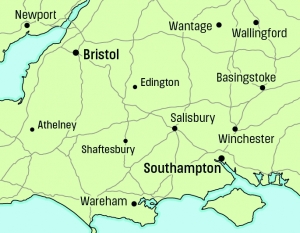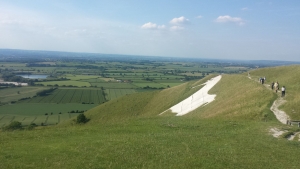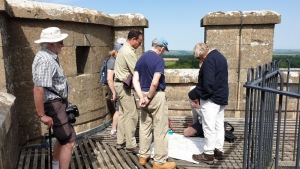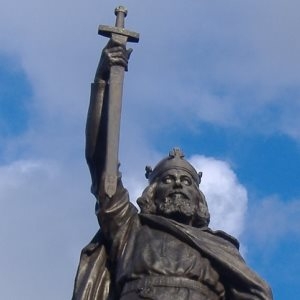
The Pale Horseman
The Wessex of Alfred the Great
Experience ToursGeneral History ToursMilitary History and Battlefield
To be confirmed
The Pale Horseman
The Wessex of Alfred the Great
Experience ToursGeneral History ToursMilitary History and Battlefield
Tour Introduction
Travelling and walking through some of the finest English landscapes, we will try to understand how Anglo-Saxon kingship worked during this crucial period in English history as the most famous son of Wessex, Alfred the Great, fought for survival against his Viking enemies. Examining the remains of ancient fortifications and taking the high ground as we search for likely battlefields, the tour allows us to explore the reality behind Bernard Cornwell’s popular novels, The Last Kingdom and The Pale Horseman, as Alfred moved from near total defeat to crucial victory. Situated in the heart of historic Wessex, we will enjoy stunning scenery, a series of short walks and one or two country pub sandwich lunches. Our expert historian will be Professor Ryan Lavelle, author of a range of publications on the lands and politics of the Anglo-Saxon kingdoms, including Alfred’s Wars(2010). He was also historical adviser on the BBC TV adaptation The Last Kingdom
Background
Alfred of Wessex (871–99) is renowned as one of the great kings of medieval English history and is the only English king to be remembered as ‘the Great’. A major part of this reputation is built on his military leadership of the West Saxon kingdom, the last of the Anglo-Saxon kingdoms to survive the Viking onslaught of the ninth century. The youngest of five brothers to rule Wessex in turbulent times, Alfred’s accession to the throne of Wessex in 871 took place in a ‘year of battles’, the most important of which was the Battle of Ashdown, when the young prince proved his mettle against his enemies. A series of treaties with the Vikings bought time for the West Saxons but, after a surprise attack in the winter of 878, the king took refuge and finally rallied his forces to victory at the Battle of Ethandun. The peace treaty which resulted allowed the king to build a series of fortifications throughout his kingdom, which provided the heartland of the West Saxon kingdom with the strength it needed to withstand future Viking attacks.
Highlights
- Explore Saxon Winchester
- Travelling through the fine English countryside during mid summer
- Fascinating discovery of ancient Wessex
- Battles of Ashdown and Ethandun
- Visit superb museums in Winchester and Salisbury
What's Included
- 3 & 4 Star Hotels
- Expert historians throughout providing a daily variety of talks, presentations and Q&A
- Dedicated Tour Manager
- Dinner parties hosted by your expert historians and tour manager
- The company of like-minded travelers
- Helpful and friendly travel advice
- Meals as indicated in the itinerary
- Two drinks i,e wine or beer at each dinner and a welcome drink on first evening
- Entrance fees for sites included in itinerary
- Tour information booklet
- Modern, comfortable, air-conditioned coach
Itinerary
Day 1 – Winchester
We meet at midday to enjoy a sandwich lunch at our hotel in Winchester, the city most often associated with the memory of Alfred the Great and our home for the first two nights. Spend the afternoon on a walking tour of the city centre where we explore the layout of the old Roman city as it was converted to the master plan of a West Saxon burh. We also visit the magnificent Cathedral with its excellent Kings and Scribes exhibition. Here we learn about the origins of the Cathedral in Anglo Saxon times and its special importance as a key ecclesiastical centre. A relaxing evening starts with welcome drinks followed by a well-earned dinner and introductory talk. (L, D).
Day 2 - Wantage to Wallingford
We start the day at Wantage, now in Oxfordshire, Alfred’s birthplace, on the northern edge of the West Saxon kingdom. A short drive to the Ridgeway, one of the most important routes across northern Wessex, helps us to understand how the king’s childhood home became threatened by Viking forces. We take a gentle walk along this ancient route (4 kms) to examine locations associated with the battle of Ashdown (871) and enjoy a sweeping panorama of the Anglo-Saxon landscape fought over between West Saxons and Danes. Thence to Wallingford, to examine a second Alfredian burh site before visiting a second, and perhaps, more convincing site for the battle of Ashdown overlooking the Thames Valley. (B, D).
Day 3 – Winchester and Salisbury
We spend the morning enjoying Winchester’s superb museums where we get close to Alfred’s burgh and its legacy. First we visit the fantastic AD 878 Immersive Experience where we step back in time to Anglo-Saxon England before perusing the rich collection at Winchester City and Westgate Museums. After lunch we drive the short distance to the lovely town of Salisbury to tour the ancient stronghold of Old Sarum; with over 2,000 years of history this was the site of Salisbury’s first cathedral. The site was used during the disastrous reign of Alfred’s great- great-grandson, Æthelred ‘the Unready’ (978–1016). Standing atop its ramparts will help us to understand the tragic epilogue to Alfred’s story as the attacks on southern England took their toll during the ‘Second Viking Age’ and the English kingdom finally fell to a Danish King, Cnut, in 1016. We then visit Salisbury Museum where we view some superb Anglo-Saxon artefacts including the rare Warminster Jewel, dating from the time of Alfred. We proceed to our Hotel in Salisbury– 2 nights. (B, D).
Day 4 - Ethandun, Alfred’s Tower, Athelney
The drama of Alfred’s story really comes alive when we travel to the area overlooking Selwood, where the three shires of Somerset, Wiltshire and Dorset meet and ‘Ecgberht’s Stone’ was once used to assemble the forces of Wessex. We ascend the eighteenth-century ‘Alfred’s Tower’, overlooking this ancient landscape, and then continue to the ancient Bratton Camp with its White Horse and stunning views, near the small Wiltshire village of Edington, to discuss the most likely site of the bloody battle of Ethandun, which saw Alfred’s 878 victory. We continue west to where Alfred was forced into exile into the Somerset Levels. A visit to the refuge upon raised ground at Athelney, ‘the Princes’ Isle’, helps us to understand how, surrounded by marshes, the king was able to hold this last western toe-hold of his embattled kingdom. Return to Salisbury. (B, D).
Day 5 – Wareham, Shaftesbury Abbey, Badbury Rings
This morning we explore the remains of Shaftesbury Abbey, built by Alfred around 888, with its fine modern statue, and visit the museum with its Saxon exhibits. We will have time to enjoy stunning views over the Blackmore Vale before driving to the Dorset town of Wareham, where Vikings used subterfuge to escape the West Saxons in 876. Thence to the Iron Age fort at Badbury Rings occupied by Alfred’s son, Edward the Elder, in 899 as he opposed the revolt of Aethelwold following his father’s death. Return to Winchester mid-afternoon. (B).
Recommended Reading List
- Alfred the Great
- Alfred the Great: War, Kingship and Culture in Anglo-Saxon England
- Alfred's Wars: Sources and Interpretations of Anglo-Saxon Warfare in the Viking Age
- Alfred: Warrior King
- Fortifications in Wessex c. 800-1066: The Defences of Alfred the Great Against the Vikings
Photo Gallery
-
St Martin's church Wareham
-
On the walls of Old Sarum
-
Dr Lavelle discusses the legend of Wayland's Smithy
-
Wayland's Smithy
-
Monument to the battle of Ethandun / Edington 878
-
King Alfred's Tower
-
Pre tour briefing from Ryan Lavelle in the lounge of hotel
-
Dr Lavelle recounts the truce of 876 upon Wareham's western walls
-
The views from the top of Alfred's tower
-
Battlefield of Ashdown
-
Stunning view from Uffington Castle on Ashdown
Your Holiday Essentials
To be confirmed
click here to register your interest
Tour Reviews
Take a look at some independent reviews of this tour by previous participants here
Take a look at some of the images taken on our most recent tour

















